Arthur ‘Cutter’ Murray reckoned that thylacines (Tasmanian tigers) followed him when he walked from Magnet to Waratah in the state’s far north-west—out of curiosity, rather than malicious intent. If he swung around suddenly he could catch a glimpse of one.[1] However, Cutter did better than that. In 1925 he caught a tiger alive and took it for a train ride to Hobart.
Tigers are just one element of the twentieth-century tale of Cutter and his elder brother Basil Murray. Yet for all their exploits these great high country bushmen started in poverty and rarely glimpsed anything better. Cutter married and produced a family, but his weakness all his working life was gambling: what he made on the possums (and tiger) he lost on the horses. Basil made enough money to keep the taxman guessing but was content to live out his days in a caravan behind Waratah’s Bischoff Hotel.[2]
Their ancestry was Irish Roman Catholic. Basil Francis Murray (1893–1971) was born to Emu Bay Railway ganger Edward James (Ted) Murray and Martha Anne Sutton. He was the couple’s ninth child. Arthur Royden Murray (1898–1987?) was the twelfth.[3] Three more kids followed. The family lived at the fettlers’ cottages at the Fourteen Mile south of Ridgley while Ted Murray was a ganger, but in 1907 he became a bush farmer at Guildford, renting land from the Van Diemen’s Land Company (VDL Co).[4] Guildford, the junction of the main Emu Bay Railway line to Zeehan and the branch line to Waratah, had a station, licensed bar and state school, but was also a centre for railway workers, VDL Co timber cutters and hunters. Edward Brown, the so-called ‘Squire of Guildford’, dominated local activity.
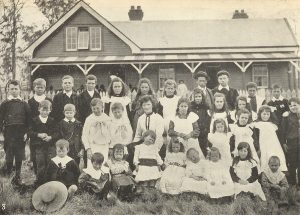
Squaring sleepers, splitting timber, hunting, fencing, scrubbing out bush, driving bullocks, herding stock, milking cows and setting snares were essential skills for a young man in this locality. Like others, the Murrays snared adjoining VDL Co land, paying the company a royalty. Several Murray boys escaped Guildford by serving in World War One, but Cutter recalled that his father would not let him enlist.[5] Basil also stayed home.[6] Perhaps it was enough for Ted and Martha Murray that they lost one son, Albert Murray, killed in action in France in 1916.[7]
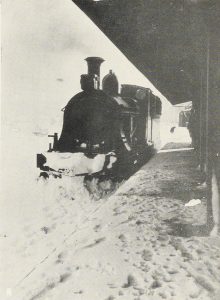
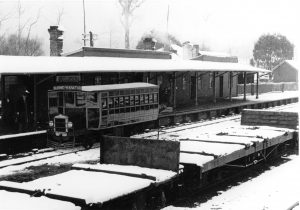
Twenty-three-year-old Arthur Murray appears to have married Alice Randall in Waratah during the ‘great snow’ of August 1921. He would already have been a proficient bushman. Cutter learned to use the treadle snare with a springer, although he would also employ a pole snare for brush possum and would shoot ringtails. He shot at night using acetylene light to illuminate the nocturnal ringtails, but he found it easier to go after them by day by poking their nests in the tea-tree scrub. ‘It was like shooting fish in a barrel’, Cutter’s son Barry Murray recalled. ‘It was only shooting as high as the ceiling … A little spar and you just shook it … and they’d come out, generally two, a male and a female …’[8] Hunters aimed for the nose so as to keep the valuable fur untainted.
In the bush Cutter lived so roughly that no one would work with him. Some tried, but none of them lasted. His huts and skin sheds on the Surrey Hills were little more than a few slabs of bark. Friday was bath day, which meant a walk in Williams Creek (east of the old Waratah Cemetery), regardless of weather conditions. Cutter’s son Val once snared Knole Plain with him, but couldn’t keep up. Snares had to be inspected every day, the game removed, and the snares reset. Cutter and Val took snaring runs on opposite sides of the plain, but Val found that even if he ran the whole way and didn’t reset any snares, Cutter would be sitting waiting for him, having long completed his side.
Cutter’s most substantial skin shed was near home base, on the hill above the primary school at Waratah. Here he would smoke the skins before an open fire. He pegged them out both on the wall and on planks about eighteen inches wide, each plank long enough to accommodate three wallaby skins. When the sun shone, he took the laden planks outside; otherwise he sat inside the skin shed with his skins, chain smoking cigarettes in empathy. A skin shed had no chimney, the idea being that the smoke would brown the skins as it escaped through the cracks between the planks of the walls. The air was so black with smoke that Cutter was virtually invisible from the doorway.[9] Yet no carcinogens prevented him reaching his eighties.
Joe Fagan claimed that Basil Murray was such a good snarer that he once snared Bass Strait.[10] Basil preferred the simple necker snare to the treadle, and caught a tiger in such a device on Murrays Plain, a little plain above the 40 Mile mark on the railway named after Ted Murray.[11] Cutter caught a couple of three-quarters-grown tigers. One was taken dead in a treadle snare with a springer on Goderich Plain when Cutter was hunting with Joe Fagan.[12] Joe kept the skin for years as a rug, but when it grew moth-eaten he tossed it on the fire—oblivious to its rarity or future value.[13] Cutter caught the other thylacine alive in a treadle near Parrawe.[14] He trussed her up and humped her home, where ‘a terrific number of people’ came for a look.[15] ‘They’re very shy animals really, and quite timid’, he recalled of the captive female. ‘It behaved just like a dog and it got very friendly. But when a stranger came near it would squark at them.’[16] At first he couldn’t get her to eat. The breakthrough came when he skinned a freshly caught wallaby, rolled the carcase up in the skin with the fur on the inside, and fed it to the tiger while it was still warm.[17] In June 1925 ‘Murray bros, Waratah’ advertised a ‘Tasmanian Tiger (female)’ in the ‘For sale’ columns of the Examiner and Mercury newspapers.[18] Hobart’s Beaumaris Zoo offered £30 for it, prompting Cutter to deliver her by train. It was his only visit to Hobart. Four cruisers of the American fleet were in town, and Cutter recalled that ‘it was so crowded you could hardly move. I didn’t like it much’.[19]
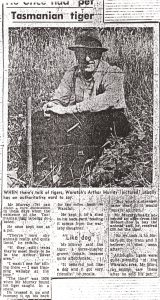
The other big event in Hobart at the time was the Adamsfield osmiridium rush, which ensnared Basil Murray. In the last quarter of 1925 he pocketed £126 from osmiridium, the equivalent of a year’s wage for a farmhand.[20] Later he spent six months mining a tin show alone at the Interview River. Having set the exact date he wanted to be picked up by boat at the Pieman River heads, Basil hauled out a ton of tin ore on his back, bit by bit.[21] On another occasion he worked a little gold show on the Heazlewood River, curling the bark of gum saplings to make a flume in order to bring water to the site.[22]
It was pulpwood cutting that gave Arthur Murray his nickname. When Associated Pulp and Paper Mills (APPM) started manufacturing paper at Burnie in 1938, it turned to Jack and Bern Fidler of Burnie company Forest Supplies Pty Ltd for pulpwood.[23] Over the next two decades Joe Fagan supplied about one-third of the pulpwood quota as a sub-contractor to the Fidlers. At a time when Mount Bischoff was a marginal provider for a few families, and osmiridium mining had fizzled out, Fagan became a significant employer, with about 65 men splitting barking and carting cordwood to the railway at Guildford for transport to Burnie.[24]
A good splitter would split about 3 cords of wood (a cord equals 128 cubic feet of timber) per day. Cutter held the record for the best daily effort, 8½ cords. Unlike most splitters, he never used an axe, but wedged off and split the billet into three pieces. Yet Cutter’s pulpwood stacking exasperated Joe Fagan. Unlike other men, Cutter did not stack his pulpwood as he went. Pulpwood cutters were paid according to the size of their stacks, and the large gaps in Cutter’s hasty, last-minute efforts ensured that he got paid for a bit more fresh air than he was entitled to. Kicking one such stack, Joe growled:
‘I don’t mind the rabbits goin’ through, Arthur, but I bloody well hate those bloody greyhounds behind them goin’ through the holes’.[25]
World War Two was a lucrative time for snarers. £15,000-worth of skins were auctioned at the Guildford Railway Station in 1943, while more than 32,000 skins were offered there in the following year. Record prices were paid at what was probably the last annual Guildford sale in 1946.[26] Taking advantage of high demand, the VDL Co dispensed with the royalty payment system and made the letting of runs its sole hunting revenue. One party of three hunters was reported to have presented about three tons of prime skins as its seasonal haul.[27]
Both Murrays cashed in. Cutter made £600 one season.[28] Working with Eric Saddington at the Racecourse, Surrey Hills, Basil took 3000 wallabies in 1943. Unfortunately their wallaby snares also landed 42 out-of-season brush possums (21 grey and 21 black)—which landed the pair in court on unlawful possession charges. Both men were fined.[29] Basil had a reputation for being a ‘poacher’, and one story of his cunning, apocryphal or not, rivals those told about fellow poacher Bert Nichols.[30]
According to Ted Crisp, Basil was sitting at the bar at the Guildford Junction Railway Station when two Fauna Board rangers came in on the train and announced they were looking for Basil Murray, whom they believed had a stash of out-of-season skins. Then they set off for his hut, rejoining the train to go further down the line:
‘Old Baz headed down by foot and took after them, he was a pretty good mover in the bush and the trains weren’t real fast … and by the time he got down there, they’d found his skins, decided there were too many to carry out so they’d hide them and pick them up at a later date, and of course old Baz was sitting there watching them, they had to catch the train back a couple of hours later, they left and old Baz picked up the skins and moved them to another place …’
By the time the Fauna Board rangers got back to Guildford, Basil was still in the bar, propped up against the counter.[31] However, the taxman did better than the Fauna Board rangers. Basil seems to have been a chronic tax avoider. He and Eric Saddington were camped at Bulgobac, squaring sleepers and snaring, when they were busted for not filing tax returns for the years 1941–42–43.[32]
Basil kept on in the same vein, landing a £25 fine for not lodging a 1943–44 return and then a whopping £60 for the 1947–48–49 period.[33] Things finally got too hot for Basil, who adjourned to the Victorian goldfields for a time.[34]
In 1951 Basil was the cook for the party re-establishing the track between Corinna and Zeehan. One of the track-makers, Basil’s nephew Barry Murray remembered him as ‘a good old cook, as clean as Cutter was rough. They were just opposites. He had a big Huon pine table. He used to scrub it with sandsoap every day, and he would have worn it away if he’d stopped there for two or three years’.[35] Basil became well known as APPM’s gatekeeper at the Hampshire Hills.
In 1963 Cutter Murray was one of Joe Fagan’s men recruited by Harry Fraser of Aberfoyle in a party which investigated the old Cleveland tin and tungsten mine and recut the Yellowband Plain track to Mount Lindsay. At the party’s Mount Lindsay camp Cutter used snares to reduce the numbers of marauding devils that were tearing through the canvas tents, biting the tops off sauce bottles and biting open tins of beef and jam.[36]
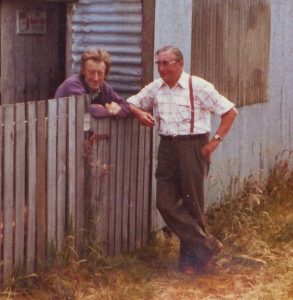
Cutter snared until virtually the day he died in the 1980s, making him—along with Basil Steers—one of the last of the snarers. He possumed on North’s block and took wallabies on the Don Hill, under Mount Bischoff, wheeling the skins home draped over a bicycle. A great snaring dog, a labrador that he had trained to corner but not kill escaped game, made his life easier.[37] Nothing is known to remain of his hunting regime, not a hut or a skin shed. Barely a photo remains of the hardy bushman. His tiger tale flitted across the country via newspaper in 1984, then was forgotten.
Unfortunately Cutter Murray’s travelling tiger has an equally obscure legacy, apparently dying soon after it was received at the Beaumaris Zoo.[38]
[1] Barry Murray, interviewed by Nic Haygarth, 21 November 2008.
[2] Barry Murray, interviewed by Nic Haygarth, 23 July 2011.
[3] Registration no.484, born 16 May 1898, RGD33/1/85 (TAHO). Basil Murray’s years of birth and dirt are recorded on his headstone in the Wivenhoe General Cemetery, Burnie.
[4] ‘Ridgley’, North West Post, 8 October 1907, p.2.
[5] Cutter Murray; quoted by Mary McNamara, ‘Have Tasmanian tiger, will travel … but only once’, Australian, 1984, publication details unknown.
[6] Basil and John Murray were refused an exemption (‘Waratah Exemption Court’, North Western Advocate and the Emu Bay Times, 11 November 1916, p.2; ‘Burnie: in freedom’s cause’, North Western Advocate and the Emu Bay Times, 13 January 1916, p.2), but there is no record of Basil serving.
[7] ‘Tasmanian casualties’, North Western Advocate and the Emu Bay Times, 22 September 1916, p.3.
[8] Barry Murray, interviewed by Nic Haygarth, 23 July 2011.
[9] Barry Murray, interviewed by Nic Haygarth, 23 July 2011.
[10] Joe Fagan to Bob Brown and Ern Malley, 1972 (QVMAG).
[11] Barry Murray, interviewed by Nic Haygarth, 23 July 2011.
[12] Cutter Murray and Joe Fagan to Bob Brown and Ern Malley, 1972 (QVMAG).
[13] Harry Reginald Paine, Taking you back down the track … is about Waratah in the early days, the author, Somerset, 1994, pp.62–66.
[14] Cutter Murray and Joe Fagan to Bob Brown and Ern Malley, 1972 (QVMAG).
[15] Cutter Murray; quoted by Mary McNamara, ‘Have Tasmanian tiger, will travel … but only once’, Australian, 1984, publication details unknown.
[16] Cutter Murray; quoted in ‘He once had pet Tasmanian tiger’, Mercury, 13 February 1973.
[17] AAC (Bert) Mason, No two the same: an autobiographical social and mining history 1914–1992 on the life and times of a mining engineer, Australasian Institute of Mining and Metallurgy, Hawthorn, Vic, 1994, p.571.
[18] See, for example, ‘For sale’, Examiner, 17 Jun 1925, p.8.
[19] Cutter Murray; quoted by Mary McNamara, ‘Have Tasmanian tiger, will travel … but only once’.
[20] Register of osmiridium buyers’ return of purchases, MIN150/1/1 (TAHO).
[21] Barry Murray, interviewed by Nic Haygarth, 21 November 2008.
[22] Barry Murray, interviewed by Nic Haygarth, 23 July 2011.
[23] Steve Scott, quoted by Tess Lawrence, A whitebait and a bloody scone: an anecdotal history of APPM, Jezebel Press, Melbourne, 1986, p.25.
[24] Kerry Pink, ‘His heart belongs to Waratah … Joe Fagan’, Advocate, 10 August 1985, p.6.
[25] Barry Murray, interviewed by Nic Haygarth, 21 November 2008.
[26] ‘£15,000 skin sale at Guildford’, Examiner, 14 October 1943, p.4; ‘Over 32,000 skins offered at sale’, Advocate, 13 September 1944, p.5; ‘Record prices at Guildford skin sale’, Advocate, 30 July 1946, p.6.
[27] ‘£15,000 skin sale at Guildford’, Examiner, 14 October 1943, p.4.
[28] Barry Murray, interviewed by Nic Haygarth, 23 July 2011.
[29] ‘Trappers fined’, Advocate, 22 October 1943, p.4.
[30] For Nichols’ poaching, see Simon Cubit and Nic Haygarth, Mountain men: stories from the Tasmanian high country, Forty South Publishing, Hobart, 2015, pp.116–19.
[31] Ted Crisp; quoted by Tess Lawrence, A whitebait and a bloody scone: an anecdotal history of APPM, p.26.
[32] ‘Men fined’, Mercury, 5 May 1944, p.6.
[33] ‘Fines imposed for income tax offences’, Mercury, 5 September 1946, p.10; ‘Fined for tax breaches’, Examiner, 6 July 1950, p.3.
[34] Barry Murray, interviewed by Nic Haygarth, 23 July 2011.
[35] Barry Murray, interviewed by Nic Haygarth, 23 July 2011.
[36] AAC (Bert) Mason, No two the same, pp.570–71, 577, 579.
[37] Barry Murray, interviewed by Nic Haygarth, 23 July 2011.
[38] Email from Dr Stephen Sleightholme 26 December 2018; Cutter Murray stated his belief that it died soon after arrival in Hobart in ‘He once had pet Tasmanian tiger’. I thank Stephen Sleightholme and Gareth Linnard for their contributions to this story.